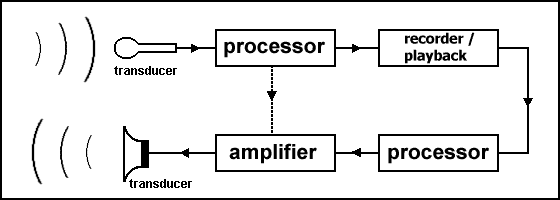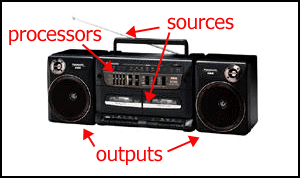Sound Systems
Working with audio means working with sound systems. Naturally, the range of systems available for different applications is enormous. However, all electronic audio systems are based around one very simple concept: To take sound waves, convert them into an electric current and manipulate them as desired, then convert them back into sound waves.
A very simple sound system is shown in the diagram below. It is made up of two types of component:
- Transducer - A device which converts energy from one form into another. The two types of transducers we will deal with are microphones (which convert acoustical energy into electrical energy) and speakers (which convert electrical energy into acoustical energy).
- Amplifier - A device which takes a signal and increases its power (i.e. it increases the amplitude).

- The process begins with a sound source (such as a human voice), which creates waves of sound (acoustical energy).
- These waves are detected by a transducer (microphone), which converts them to electrical energy.
- The electrical signal from the microphone is very weak, and must be fed to an amplifier before anything serious can be done with it.
- The loudspeaker converts the electrical signal back into sound waves, which are heard by human ears.
The next diagram shows a slightly more elaborate system, which includes:
- Signal processors - devices and software which allow the manipulation of the signal in various ways. The most common processors are tonal adjusters such as bass and treble controls.
- Record and playback section - devices which convert a signal to a storage format for later reproduction. Recorders are available in many different forms, including magnetic tape, optical CD, computer hard drive, etc.

- The audio signal from the transducer (microphone) is passed through one or more processing units, which prepare it for recording (or directly for amplification).
- The signal is fed to a recording device for storage.
- The stored signal is played back and fed to more processors.
- The signal is amplified and fed to a loudspeaker.
The 3-part audio model
One simple way of visualising any audio system is by dividing it up into three sections: the source(s), processor(s) and output(s).
- The source is where the electronic audio signal is generated. This could be a "live" source such as a microphone or electric musical instrument, or a "playback" source such as a tape deck, CD, etc.
- The processing section is where the signal is manipulated. For our purposes, we will include the amplifiers in this section.
- The output section is where the signal is converted into sound waves (by loudspeakers), so that it can be heard by humans.

This portable stereo is a good example of a simple system.
Sources: There are three sources - two tape machines and one radio aerial (technically the radio source is actually at the radio station).
Processors: Includes a graphic equaliser, left/right stereo balance, and amplifiers.
Outputs: There are two speaker cabinets (one at each end), each containing two speakers. Note that there are also two alternative outputs: A headphone socket (which drives the small speakers inside a headphone set) and twin "line out" sockets (which supply a feed for an external audio system).
Now imagine a multi-kilowatt sound system used for stadium concerts. Although this is a complex system, at it's heart are the same three sections: Sources (microphones, instruments, etc), processors and speakers.
Whatever the scale of the project, the same underlying principles of sound reproduction apply.
That's the end of this introductory tutorial. If you have any questions please post them in the audio forum.